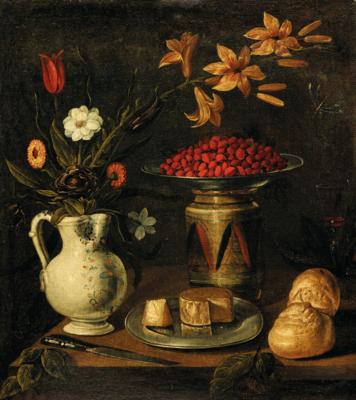School of Valencia, 17th Century

Lilies, daffodils, a tulip and other flowers in a painted ceramic vase, cheese on a metallic plate, a knife and bread besides, an etagere with wild strawberries and a glass of red wine, on a wooden table,
oil on canvas, 63.2 x 56.3 cm, framed
Still life painting became a genre in itself in European art at the beginning of the seventeenth century, in part, due to the extraordinary achievements in the genre by Caravaggio. Despite revealing certain points of contact both with Italian, Dutch and Flemish examples, Spanish still life painting reveals its own peculiar characteristics. Spanish works are usually adorned with simple, every-day furnishings and they do not display the extravagance of their North European counterparts, which aimed to demonstrate the high social status of the owners.
The originator of this genre in Spain is believed to have been Juan Sánchez Cotán (1560–1627), a Carthusian monk from Toledo, who painted austerely restrained compositions with moralising meanings. Subsequently all the great Spanish masters executed still life paintings from Velázquez to Goya right up to the masters of the twentieth century avantgarde such as Picasso and Mirò.
Esperto: Mark MacDonnell
 Mark MacDonnell
Mark MacDonnell
+43 1 515 60 403
oldmasters@dorotheum.com
03.05.2023 - 18:00
- Stima:
-
EUR 20.000,- a EUR 30.000,-
School of Valencia, 17th Century
Lilies, daffodils, a tulip and other flowers in a painted ceramic vase, cheese on a metallic plate, a knife and bread besides, an etagere with wild strawberries and a glass of red wine, on a wooden table,
oil on canvas, 63.2 x 56.3 cm, framed
Still life painting became a genre in itself in European art at the beginning of the seventeenth century, in part, due to the extraordinary achievements in the genre by Caravaggio. Despite revealing certain points of contact both with Italian, Dutch and Flemish examples, Spanish still life painting reveals its own peculiar characteristics. Spanish works are usually adorned with simple, every-day furnishings and they do not display the extravagance of their North European counterparts, which aimed to demonstrate the high social status of the owners.
The originator of this genre in Spain is believed to have been Juan Sánchez Cotán (1560–1627), a Carthusian monk from Toledo, who painted austerely restrained compositions with moralising meanings. Subsequently all the great Spanish masters executed still life paintings from Velázquez to Goya right up to the masters of the twentieth century avantgarde such as Picasso and Mirò.
Esperto: Mark MacDonnell
 Mark MacDonnell
Mark MacDonnell
+43 1 515 60 403
oldmasters@dorotheum.com
|
Hotline dell'acquirente
lun-ven: 10.00 - 17.00
old.masters@dorotheum.at +43 1 515 60 403 |
| Asta: | Dipinti antichi |
| Tipo d'asta: | Asta in sala con Live Bidding |
| Data: | 03.05.2023 - 18:00 |
| Luogo dell'asta: | Wien | Palais Dorotheum |
| Esposizione: | 22.04. - 03.05.2023 |
